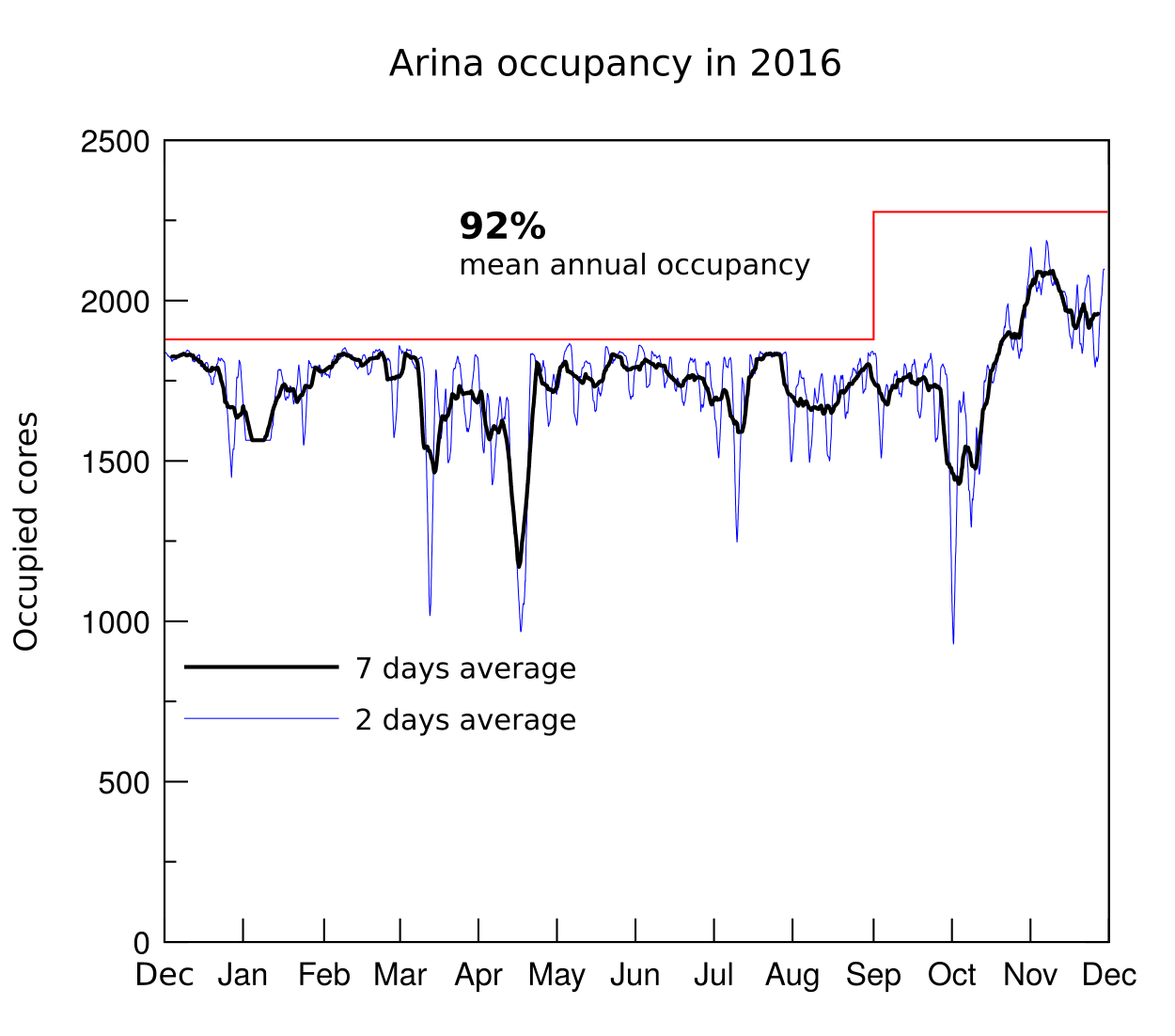2016 Report
We close 2016 with an occupancy record of 92% in the Arina cluster of the IZO-SGI Scientific Computing Service. This occupation shows an excellent usage of the resources and inversions. The counterpart has been a slight increase in queue time, although we hope that this will be reduced in 2017 after the two increases in computing resources installed at the end of 2016 and mid-2017. On the other hand, it is also worth highlighting the increase in the number of publications which thanks to the Service.
The table at the end of this article contains the most relevant figures for the Service. Full details can be found in the Service’s memory at the following link (in spanish):
2016 Scientific Computing Service report (pdf)
Aknowledgements
We would like to thank the researchers for their trust in the Service, since the good numbers of the Service have been their achievements.
The Scientific Computing Service in figures
The following table summarizes the most significant data of the Scientific Computing Service in the last years.
| 2012 | 2013 | 2014 | 2015 | 2016 | |
| Computing cores | 1.520 | 1.4 | 1.300¹ | 1.852 | 2.272² |
| Used millions of computing hours | 11,3 | 10,4 | 10,1 | 14,0 | 15,2 |
| Active researchers | 89 | 99 | 107 | 104 | 116 |
| Activos groups | 40 | 47 | 45 | 42 | 38 |
| New accounts | 20 | 34 | 23 | 43 | 43 |
| Researcher’s satisfaction³ | 9,3 | 9,3 | 9,6 | 9,5 | 9.5 |
| Scientific articles⁴ | 74 | 87 | 75 | 85 | 94 |
| Web visits | 9.899 | 5.924 | 2.34 | 2.902 | 5.152 |
| Page views | 30.738 | 20.323 | 12.057 | 10.799 | 12.887 |
| Posts in the HPC blog | 27 | 47 | 36 | 30 | 11 |
| Page views of the HPC blog | 4.741 | 24.613 | 23.677 | 20.67 | 18.554 |
| Arina | |||||
| Computing cores | 1.360 | 1.32 | 1.3 | 1.892 | 2.172² |
| Used millions of computing hours | 9,6 | 9,8 | 10,1 | 14,0 | 15,2 |
| Average occupation | 79 % | 83 % | 87 % | 86 % | 92 % |
| Sent jobs | 98.383 | 100.214 | 76.912 | 115.681 | 115.172 |
| Jobs larger than 2 minutos⁵ | 78.846 | 75.406 | 64.335 | 100.131 | 98.472 |
| Average hours per job⁶ | 122 | 130 | 156 | 140 | 132 |
| Waiting time per job ⁷ | 5,2 | 5,5 | 10,0 | 14 | 15,1 |
| Péndulo | |||||
| Computing cores | 80 | 80 | 70 | — | — |
| Used millions of computing hours | 0,07 | 0,04 | 6 | — | — |
| Ikerbasque⁸ | |||||
| Computing cores | 208 | 208 | — | — | — |
| Used millions of computing hours | 1,6 | 0,55 | — | — | — |
¹ At the end of 2014 the numbers of cores increased up to 1850.
² In September the number of cores increased up to 2016.
³ Service User Satisfaction Survey.
⁴ With thanks to IZO-SGI.
⁵ Jobs of less than 2 minutes are usually due to unsuccessful runs that end immediately with an error. In any case, even if this is not the case, given their short duration, they do not affect the cluster.
⁶ Jobs of less than two minutes has not been taken into account.
⁷ Jobs are executed through a queue system that assigns to each job the resources that have been requested and orders its execution to optimize the use of the cluster. Queue time is the time that jobs are waiting until the resources they need are released.
⁸ The machine was shut down in April 2013.


Comentarios